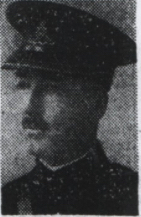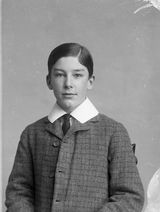George St John Armitage Dyson

| Rank: | Lieutenant Colonel |
| Regiment: | Royal Artillery, Cdg. 122 Field Regiment |
| Country: | Japan |
| Service Number: | 8409 |
| Cemetary/Memorial: | Yokohama War Cemetary (Brit. Sec. D.D.12.) |
| Awards: | Victory Medal 1914 – 1915 Star 1939 – 1945 Medal 1939 – 1945 Star Pacific Star Mentioned in Dispatches Military Cross (World War I) |
Born on 24th June 1893 in Kirkburton, Yorkshire, Lieutenant Colonel Dyson died on 22nd November 1942, aged 49, in Korea. He was being held captive in a Japanese Prisoner of War Camp following the fall of Singapore.
 He was the only son of Thomas James Dyson (solicitor) and Julia Ethel Dyson (nee Armitage) and elder brother to Nancy (1901-1986).
He was the only son of Thomas James Dyson (solicitor) and Julia Ethel Dyson (nee Armitage) and elder brother to Nancy (1901-1986).
On a posting to India he met his wife, Mona, an Australian woman who was touring the country with her parents. They married in Queensland, Australia in 1921, on his birthday. At the time of his death, they were resident in Norton Sub Hamdon, Somerset.
He was father to Thomas ‘Tim’ Norwood Armitage Dyson (b. 1922), who unfortunately died, aged 16, on 26th August 1938 at Trimulgherry, Secunderabad, India, from diptheria whilst visiting his parents during the school summer holidays.
George was a pupil at St Ronan’s from 1902 to 1907 where he was described as a very promising footballer. He was a Prefect. In 1905, George’s mother donated a pair of altar vases to the chapel.
In 1914, The Ronian lists George as a Lieutenant fighting on the front in the First World War. He was decorated with the award of the Military Cross in 1917, having seen action in France, Gallipoli and Egypt. He returned to visit the school in 1930.
He went on to Harrow (Mr Somervell’s House) where he was in the school gymnasium team. He left Harrow in 1911 to attend RMC Woolwich. He passed out of RMC in 1913, qualifying for a commission in the Royal Artillery.
In the Second World War, he gained the rank of Lieutenant-Colonel in the service of the 122nd (West Riding) Field Regiment, Malaya Command Reserve.
122 Field Regiment Royal Artillery was a Territorial regiment formed in Bradford on 1st June 1939 along with 70 Field Regiment. Both Regiments had the title 'West Riding'.
On 3rd January 1941the Regiment embarked at Glasgow on the Canadian Pacific liner 'Empress of Japan' and arrived in Malaya on 11th March, to become part of the 12th Indian Brigade.
When the Japanese invaded Malaya the following December, the Regiment was sent up country to face them and fought its way all down the Peninsular, before being captured, in the battle for Singapore Island.
The three and a half years of captivity in inhuman conditions cost the Regiment dearly. Its members were scattered all over the Far East. Many were sent as slave labour to build the infamous Burma/Siam Railway on which it was reckoned that one prisoner died for every sleeper laid.
On 4th March 1942, only three weeks after the Fall of Singapore, the Commander of the Korean Army, General Seishiro Itagaki sent a telegram to the Japanese War Ministry requesting 2,000 white Prisoners of War (half British, half American) be sent to Korea. The number of prisoners was reduced to 1,000. The names of those being relocated was posted on 16th July. The group comprised two parties, A and B:
• The "A" Party, later known as the "Special Party" or “Senior Officers Party”, comprising senior Malayan and NEI (Netherland East Indies) government officials, plus British, Dutch and Australian officers with the rank of full colonel and above, and engineers and technicians, numbered only 400.
• The 1,000-strong "B" Party (sometimes called the “Working Party”), was largely made up of the surviving members of the 2nd Battalion Royal Lancashire Regiment and the Yorkshire-based 122 Field Regiment, Royal Artillery, with the remaining places filled from various British and AIF (Austrailian Imperial Force) units.
After consultation with their junior staff, the commanding officers of the 2nd Royals and the 122nd Field Regiment, Lieutenant-Colonel Michael Elrington and Colonel John Dyson respectively, volunteered for the Japanese Party for several reasons, but most importantly to keep their units intact and to escape the tropics. Both were decorated career officers, Elrington having won a Distinguished Service Order and Military Cross in the Malayan Campaign and Dyson a Military Cross and they had the confidence and cooperation of their men.
On 16th August, after being stripped and disinfected, the prisoners were shipped in appalling conditions onboard the Fukkai Maru for the 40 day voyage from Singapore to Korea.
By 22nd September, when the Fukkai Maru anchored in Fusan Bay, most of the prisoners were suffering from diarrhoea, beri-beri and dysentery. The Japanese guard split the prisoners into two groups, assigning the Royals, the AIF and all field officers to Keijo prisoner of war camp, and the 122nd Field Regiment and personnel from other corps to Jinsen camp where Lieutenant Colonel Dyson died.
In August 1946, Lieutenant-Colonel Dyson was Mentioned in Dispatches, “In recognition of gallant and distinguished services in Malaya in 1942” (London Gazette).

